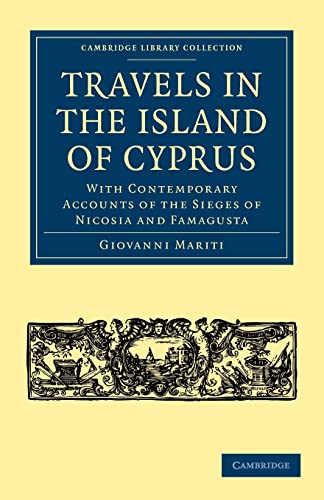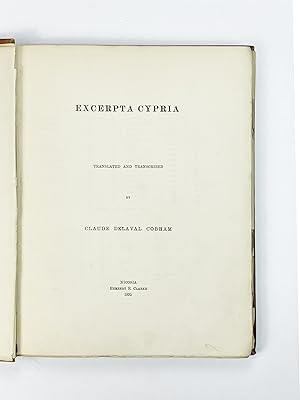CLAUDE DELAVAL COBHAM TRANSLATOR (2 résultats)
Type d'article
- Tous les types d'articles
- Livres (2)
- Magazines & Périodiques
- Bandes dessinées
- Partitions de musique
- Art, Affiches et Gravures
- Photographies
- Cartes
-
Manuscrits &
Papiers anciens
Etat
Reliure
- Toutes
- Couverture rigide
- Couverture souple (1)
Particularités
- Edition originale
- Signé
- Jaquette
- Avec images (1)
- Sans impression à la demande
Pays
Evaluation du vendeur
-
Travels In The Island Of Cyprus: With Contemporary Accounts Of The Sieges Of Nicosia And Famagusta
Edité par Cambridge University Press, 2009
ISBN 10 : 1108004326ISBN 13 : 9781108004329
Vendeur : Revaluation Books, Exeter, Royaume-Uni
Livre
Paperback. Etat : Brand New. 199 pages. 8.75x5.75x0.50 inches. In Stock.
-
Excerpta Cypria.
Edité par Nicosia: Herbert E. Clarke, ., 1895
Vendeur : Antiquariat Dasa Pahor GbR, München, Allemagne
Livre
4° (29.5 x 22.5 cm): [3 ff.], 342 pp. [2 pp.], bound in contemporary light red cloth with gilt title to spine (Very Good, internally clean and bright, endpapers loose, binding quite sunned with minor edge-wear). CYPRUS HISTORY / NICOSIA IMPRINT: The very rare first edition of a foundational work of Cypriology, published in Nicosia, it is the first anthology of primary historical sources on the island, featuring 35 accounts, ranging in date from 1196 AD to 1870, collected and translated from 12 different languages into English by Claude Delaval Cobham, who served as the District Commissioner of Larnaca Province for 28 years, and who was one of the island s pioneering historians, archaeologists and antiquarians. - Cyprus has one of the longest and richest histories in the Mediterranean World, having been at the crossroads of many different civilizations over thousands of years. It has, at various times, been ruled by the Phoenicians, Ancient Greeks, Romans, Arabs, French Catholics, Byzantines, Venetians, and Ottomans, among others. During the period of Ottoman rule (1571-1878), Cyprus languished due the Sublime Porte s neglect, with its mostly Greek Orthodox population largely cut-off from contact with the Euro-Christian world, save for the presence of French traders along the coasts. Little effort was made to record the island s history during this time or preserving the memory of the periods before Ottoman rule, such that many consider this era to have been the cultural-historical nadir of Cyprus. In 1878, Britain gained de facto rule over Cyprus from the Ottomans, taking advantage of the Sublime Porte s weakness in the wake of its defeat during the Russo-Turkish War of 1877-8, while valuing the island s ultra-strategic location as base for its Royal Navy (the Ottomans would henceforth have no power over the island, although their de jure sovereignty would not be abolished until 1914). While British rule was colonial in nature and often patronizing, and in some ways even harsh, towards the Greek Orthodox population, it did usher in many great improvements with respect to the study and preservation of the island s history and culture. Claude Delaval Cobham: One of the First Great Modern Cypriologists - Claude Delaval Cobham (1842 - 1915) was one of the leading figures in reviving the study of Cypriot history and archaeology. A native of England, and an Oxford arts and law graduate, Cobham entered the British colonial service and was one of the first senior officials sent to Cyprus in 1878, upon the British takeover of the island. He served as the District Commissioner (essentially governor) of Larnaca Province for 28 years, from 1879 to 1907, living in a massive old mansion which he named the Villa Claudia. While a diligent and hardworking administrator, Cobham s true passion was historical discovery and he notably supervised many archaeological digs, including the excavations conducted by Max Ohnefalsh-Richte at Salamis, while he cooperated with the esteemed Cypriot antiquarian Demetrius Pierides. He also collected a vast quantity of ancient artifacts, saving many from looters, some of which are today preserved at the British Museum and the Royal Albert Memorial Museum (Exeter, England). His voluminous personal library is now housed at the University of Cambridge. An extraordinarily gifted linguist, Cobham went to great efforts to acquire and decipher innumerable rare and important primary sources on Cypriot history, taking advantage of the vast resources of the British Museum and various English libraries, so giving his academic works an unprecedented gravitas. The Present Work in Focus - Cobham s magnum opus was the Excerpta Cypria, here present in the very rare first edition, published in Nicosia by Herbert E. Clarke, in 1895. Importantly, it is the first anthology of primary sources of Cypriot history. A great achievement of scholarship, it is one of the foundational works of Cypriology. The book consists of 35 articles, personally translated by Cobham from 12 different languages, many of which were very rare and difficult to source. Thirty-four of the works are firsthand accounts of experiences in Cyprus written by Greek, Italian, French, British, Dutch, Swedish, German, and Turkish visitors or residents, with the earliest being the writings of Neophytos (1196 AD), and the most recent that of Philemon (1870), although most of articles (numbering thirty) date from the period of Ottoman rule (1571-1878). These accounts provide crucial contemporary insights into the physical appearance of places and the cultures and circumstances of their inhabitants, as well as valuable information on politics, agriculture, commerce, and taxation, in many cases not preserved by any other source. The one remaining article concerns the inscriptions on epitaphs of important people dating from between 1685 and 1849. . SEE OUR WEB PAGE FOR A LONGER DESCRIPTION References: British Library: 10077.l.20.; Cambridge University Library: RCS.Cob.18c.75 (the author s persona example); Staatsbibliothek zu Berlin: 4"@Uk 9510/10; OCLC: 251959784, 557904484; Anthi ANDRONIKOU, Italy, Cyprus, and Artistic Exchange in the Medieval Mediterranean (Cambridge, UK, 2022), p. 141; Christopher DUFFY, Siege Warfare: The Fortress in the Early Modern World 1494-1660 (London, 2013), p. 267; Orientalische Bibliographie, no. 9 (1896), p. 285.



